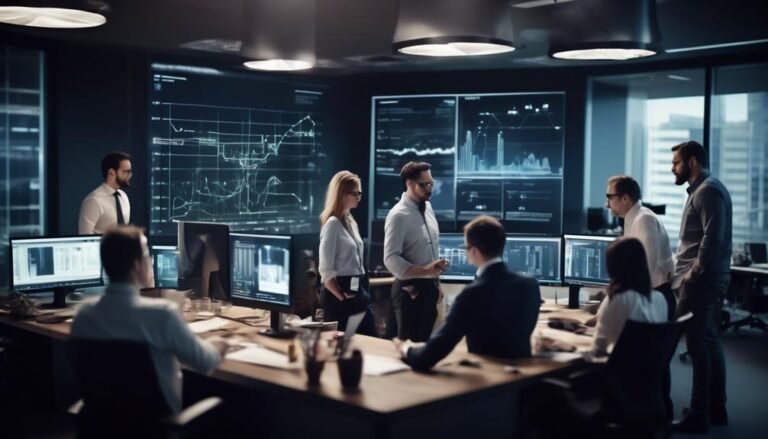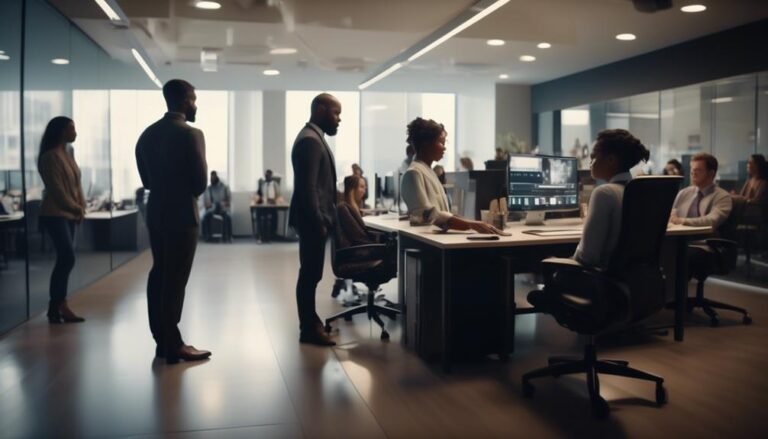Time Warner Center: Mixed-Use Development Case Study
The Time Warner Center in New York City stands as a testament to the success of mixed-use development projects. With its unique blend of commercial, residential, retail, and entertainment spaces, the center has become a landmark in the city.
The architectural design and layout of the complex have not only redefined the city's skyline but also set a benchmark for urban development.
As we delve into the case study of the Time Warner Center, we will explore the impact of this development on the surrounding area, the factors contributing to its success, and the valuable lessons learned from this iconic project.
History of Time Warner Center
The history of Time Warner Center, a landmark in the heart of New York City, is a testament to the evolution of urban development and corporate innovation in the 21st century. The center, strategically located at Columbus Circle, was inaugurated in 2003 and swiftly gained landmark status due to its architectural significance and transformative impact on the cityscape.
This iconic structure not only reshaped the New York City skyline but also redefined the concept of mixed-use real estate development. Time Warner Center symbolizes a strategic convergence of commercial, residential, and retail spaces, embodying a pioneering approach to urban planning and design.
The development of Time Warner Center marked a turning point in real estate trends, inspiring a wave of similar mixed-use projects across the globe. Its innovative fusion of luxury residences, Class A office space, a high-end shopping mall, and the renowned Mandarin Oriental hotel set a new standard for urban living.
This transformative project not only elevated the profile of its surroundings but also became a catalyst for the revitalization of the entire neighborhood. Time Warner Center stands as a testament to the power of visionary urban development in shaping the future of cities.
Architectural Design and Layout
The architectural design and layout of the Time Warner Center is a blend of functional space planning and aesthetic design elements.
The center's layout is strategically crafted to optimize the functionality of the space while also incorporating innovative design features that enhance the overall aesthetic appeal.
Functional Space Planning
Exhibiting a keen understanding of spatial dynamics and user flow, the architectural design and layout of the Time Warner Center demonstrates a strategic approach to functional space planning.
The center prioritizes space efficiency to optimize the user experience, ensuring that each area serves a specific purpose while maintaining a cohesive flow throughout the development. By strategically positioning retail, dining, entertainment, and office spaces, the design maximizes functionality without compromising aesthetics.
This approach allows for seamless navigation and enhances the overall user experience, creating an environment where individuals can easily transition between different areas while maintaining a sense of continuity. The intentional layout also fosters a sense of connectivity, encouraging interaction and engagement within the space.
Through thoughtful consideration of functional space planning, the Time Warner Center successfully harmonizes diverse elements to create a dynamic and efficient environment.
Aesthetic Design Elements
Positioned at the intersection of architectural innovation and strategic spatial design, the aesthetic elements of the Time Warner Center's architectural layout captivate with a harmonious blend of form and function. The design integration seamlessly combines aesthetic appeal with practicality, creating an environment that is visually stunning while also serving the needs of its occupants. The exterior facade's sleek lines and modern materials exude a sense of sophistication, drawing the eye and creating a memorable first impression. The interior spaces are thoughtfully designed to maximize natural light and offer panoramic views, enhancing the overall experience for visitors and occupants. The careful selection of materials, textures, and colors further adds to the aesthetic appeal, creating a cohesive and visually striking environment.
| Aesthetic Design Elements | |
|---|---|
| Exterior Facade | Sleek Lines |
| Modern Materials | |
| Interior Spaces | Natural Light |
| Panoramic Views | |
| Materials, Textures, Colors | Cohesive Selection |
| Visually Striking |
Commercial Spaces and Tenant Mix
An optimal mix of commercial spaces and tenants is a critical component in positioning the Time Warner Center as a competitive and attractive destination for both consumers and businesses. The center's success in tenant retention and leasing strategies has been instrumental in maintaining a vibrant and diverse tenant mix.
This has been achieved through a strategic approach to leasing, which involves understanding the evolving needs of both tenants and consumers.
The center's leasing strategies focus on curating a mix of tenants that complement each other, thereby creating a synergistic environment where businesses can thrive. By understanding the specific requirements and preferences of potential tenants, the Time Warner Center has been successful in attracting a diverse range of businesses, from high-end retail and dining establishments to corporate offices and experiential offerings.
Moreover, the center's commitment to tenant retention is evident in its efforts to foster long-term relationships with existing tenants. This includes providing support for their growth and adapting to their evolving needs, ensuring a stable and dynamic tenant mix.
Residential Offerings and Amenities
The residential offerings and amenities at the Time Warner Center are strategically designed to cater to the discerning needs of modern urban dwellers, incorporating innovative features and services to create a truly exceptional living experience.
- Luxury Living: The residential units at the Time Warner Center epitomize luxury living, offering expansive floor plans, high ceilings, and floor-to-ceiling windows that provide breathtaking views of the city skyline and Central Park. The interiors are meticulously designed by renowned architects and designers, featuring top-of-the-line finishes and materials that exude sophistication and elegance.
- Top-Notch Amenities: Residents of the Time Warner Center have access to an unparalleled suite of amenities, including a state-of-the-art fitness center, spa and wellness facilities, private dining and event spaces, and a landscaped terrace. Additionally, the building offers 24/7 concierge services, valet parking, and in-residence dining options, ensuring that every aspect of residents' daily lives is seamlessly catered to.
The residential offerings and amenities at the Time Warner Center set a new standard for luxury living in urban settings, providing a sophisticated and enriching lifestyle for its discerning residents.
Retail and Dining Experiences
With a focus on curating a diverse and compelling array of retail and dining offerings, the Time Warner Center strategically aligns its commercial spaces to enhance the overall experience for residents and visitors alike.
The retail experiences at the Time Warner Center are carefully curated to offer a mix of upscale, luxury brands, as well as more accessible and diverse options, ensuring that the retail offerings cater to a wide range of tastes and preferences. This strategic approach not only attracts a diverse clientele but also creates a vibrant and dynamic shopping environment.
Moreover, the dining options at the center are designed to provide a culinary journey that reflects the diverse and cosmopolitan nature of the city. From fine dining restaurants with renowned chefs to casual eateries and artisanal food markets, the dining experiences at the Time Warner Center cater to different occasions and preferences.
Entertainment and Cultural Attractions
Enhancing the cultural vibrancy and experiential diversity of the Time Warner Center, the array of entertainment options and cultural attractions is thoughtfully curated to engage visitors with unique and immersive experiences.
- Cultural Events
The Time Warner Center hosts a diverse range of cultural events, including art exhibitions, music performances, and film screenings. These events are carefully selected to appeal to a wide audience and contribute to the cultural enrichment of the community.
- Entertainment Options
From Broadway-quality theater productions to interactive multimedia installations, the entertainment options at the Time Warner Center cater to diverse tastes and preferences. Visitors can enjoy live performances, comedy shows, and other engaging experiences that are designed to captivate and entertain.
The strategic curation of cultural events and entertainment options at the Time Warner Center serves to position it as a dynamic hub for cultural exchange and artistic expression. By offering a carefully balanced mix of experiences, the center ensures that visitors are consistently engaged and inspired by the diverse array of entertainment and cultural attractions available.
Impact on Surrounding Area
The Time Warner Center has had a significant impact on its surrounding area, contributing to economic growth and urban revitalization. The development has sparked new business opportunities and increased property values, helping to stimulate the local economy.
Additionally, the center has become a focal point for cultural and entertainment activities, drawing visitors and residents to the area, further enhancing its vibrancy and appeal.
Economic Growth
The Time Warner Center has significantly contributed to the economic growth of the surrounding area through its strategic positioning as a hub for business, entertainment, and luxury retail. This has had a substantial economic impact on the community development, fostering a vibrant and thriving environment in the vicinity.
The following points highlight the specific ways in which the Time Warner Center has influenced the economic landscape:
- Job Creation: The development has created numerous job opportunities, directly and indirectly, thereby boosting employment rates in the area.
- Increased Foot Traffic: The influx of visitors to the center has led to heightened activity in the surrounding businesses, resulting in greater economic vitality for the area.
The Time Warner Center's multifaceted approach to economic growth has not only enhanced the local economy but has also been instrumental in shaping a dynamic and prosperous community.
Urban Revitalization
A crucial consequence of the Time Warner Center's impact on economic growth is its pivotal role in driving urban revitalization and rejuvenating the surrounding area.
The development has significantly contributed to the revitalization of the neighborhood through its focus on community engagement and the creation of vibrant public spaces.
By integrating retail, residential, and cultural components, the center has become a focal point for the community, attracting visitors and locals alike.
Furthermore, the center has been instrumental in job creation, with its diverse range of businesses and services providing employment opportunities and contributing to the economic impact of the area.
This strategic approach to urban revitalization has not only transformed the physical landscape but has also fostered a sense of pride and prosperity within the community, making it a model for mixed-use developments.
Success Factors and Lessons Learned
In examining the success factors and lessons learned from the Time Warner Center case study, it is evident that strategic planning and innovative design played pivotal roles in its achievement.
- Lessons Learned
- Adaptive Reuse: The successful adaptive reuse of existing structures, such as the retention of the original facades of the New York Coliseum, served as a valuable lesson in preserving historical significance within modern developments.
- Community Engagement: The project's emphasis on engaging the local community throughout the development process underscored the importance of fostering positive relationships with stakeholders and residents for sustainable success.
The key success factors in the Time Warner Center case study were notably centered around the foresight to integrate diverse elements effectively. The development's ability to harmoniously blend commercial, residential, and leisure spaces underlined the significance of holistic urban planning.
Additionally, the incorporation of sustainable design principles not only reduced environmental impact but also showcased the long-term economic benefits of environmentally conscious developments. These lessons and success factors serve as valuable insights for future mixed-use projects seeking to achieve similar levels of success.
Conclusion
In conclusion, Time Warner Center stands as a towering symbol of urban innovation and strategic mixed-use development.
With its blend of commercial, residential, retail, dining, and entertainment spaces, it has transformed the surrounding area into a vibrant, dynamic hub of activity.
Its architectural design and carefully curated tenant mix have set a new standard for integrated urban developments, offering a blueprint for future mixed-use projects to create a seamless and engaging experience for visitors and residents alike.







